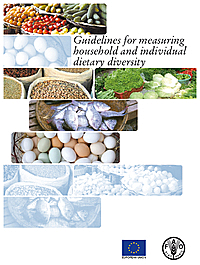Household Dietary Diversity (HDDS)
Please note:
A recent development has led to a new dietary diversity indicator, the Minimum Dietary Diversity-Women (MDD-W), to replace the Women’s Dietary Diversity Score (WDDS). However, the procedures for the assessment of Household Dietary Diversity Score (HDDS) remain unchanged. A new standalone MDD-W guide has been released in 2021, it can be downloaded here. It is recommended to follow the new procedures and guidelines for assessing Women’s dietary diversity (MDD-W) in any future studies.
Obtaining detailed data on household food access or individual dietary intake can be time consuming and expensive, and requires a high level of technical skill both in data collection and analysis. Household dietary diversity Score (HDDS) is a qualitative measure of food consumption that reflects household access to a variety of foods. HDDS is not meant to be used in accessing dietary diversity at individual level.
The household dietary diversity questionnaire represents a rapid, user-friendly and easily administered low-cost assessment tool. Scoring and analysis of the information collected with the questionnaire is straightforward. The household dietary diversity score described in the guideline consists of a simple count of food groups that a household has consumed over the preceding 24 hours. The guideline describes the use of the dietary diversity questionnaire at the household level. The data collected can also be analyzed to provide information on specific food groups of interest. The household dietary diversity score (HDDS) is meant to reflect, in a snapshot form, the economic ability of a household to access a variety of foods. Studies have shown that an increase in dietary diversity is associated with socio-economic status and household food security (household energy availability) (Hoddinot and Yohannes, 2002; Hatloy et al., 2000).

